Katja Rowell's Blog, page 5
May 14, 2013
What’s the Best Baby-Feeding Guide? Your Baby!
Trust me, I know what I’m doing…
Part of the reason so many parents get into feeding trouble is that they often lack quality support or information. Without trusted family nearby, and with pediatricians and family doctors who may not know much about feeding, parents often turn to the internet for advice.
Here is a resource from the Johns Hopkins website that a parent on FB shared with me. This Hopkins page baffled me with some of the feeding advice for parents:
“Begin with small amounts of new solid foods–a teaspoon at first and slowly increase to a tablespoon.” (Um, what if the infant doesn’t want any, or is eating eagerly and wants more? My big, healthy baby ate many tablespoons of food on many occasions, some occasions she ate nothing. How slowly to increase? Over a day, a week, ten minutes? I’m confused.)
“Infant cereals with iron should be given to your infant until your infant is 18 months old.” (I haven’t heard this before, and can’t imagine most 18 month-olds wanting to eat baby cereal. By 18 months, the toddler should be enjoying mostly the same foods as the rest of the family.)
“Feed all food with a spoon. Your baby needs to learn to eat from a spoon.” (What? Does a baby really need to learn from a spoon? All the parents who intuitively allow the baby to feed himself if he wants to, and all the moms and babies who love Baby Led Weaning, might disagree.)
“Feeding your baby solid food too early may lead to overfeeding and being overweight.” (I get annoyed when it doesn’t mention that feeding too early, which can invite feeding battles, is as likely to cause weight dysregulation on the other extreme and make feeding a negative experience, contributing to poor eating and poor weight gain…)
Overall the language is prescriptive, with absolute ounces, confusing advice and tables, and words like “needs to” and “should” and “begin”… There is very little about responding to the baby.
What is your reaction?
A Better Resource: Satter’s Guide to Following Your Baby’s Lead
Satter’s latest resource, continues to focus on helping you follow your child’s lead with feeding, while helping you do your jobs to support her eating (Division of Responsibility). It’s a new booklet from Ellyn Satter MS, RD. I just got it from the publisher last week, and it’s fantastic*. Satter’s feeding model has been around for decades, and helps parents feed in a responsive and tuned-in way. Increasingly, research is confirming that responsive feeding supports internal regulation and eating competence.
Contrast Satter’s advice to that from above:
“Let her eat her way— fast or slowly, steady or start and stop.”
“Let her eat a lot or a little. Don’t make her eat a certain amount.”
“Offer solids based on what your baby can do, not on how old he is.”
“Getting to grown-up food… Feed him when is is a little hungry, between breast or after part of the bottle…”
“Stop when he shows you he is done, even if he did not eat.”
“Give him a tablespoon or two of each food; let him have more if he wants it.”
How does this advice feel to you?
It boils down to this wisdom from a mom on my facebook page where we were having a great discussion about another feeding guideline that advised to not allow an infant more than 32 ounces of formula a day:
“Basically I dislike any advice that allows others to justify telling me to go against my baby’s cues and my judgment.”
* I receive no financial reward or other incentive to review materials, Ellyn Satter’s included, which I recommend frequently.
May 6, 2013
Touching story of progress with selective eating
This is a great post from Mealtime Hostage Blog. I am quoting generously, with permission. I love the journal-style story of progress for this mother of a selective eater. I know so many parents who think, “That sounds great, but can’t work for us.” It’s why I filled my book with tons of quotes from parents who have been there, and why I asked the Mealtime Hostage Mom if I could share this mother’s triumphs and joys. Mealtime Hostage is a great resource if you are struggling with a child who is food averse, is very selective, or has been in therapies that don’t seem to be helping. Mealtime Hostage frequently shares her own family’s journey with helping their selective son heal his eating challenges and anxieties.
From the post:
…Heavy handed, pressure-based advice has the potential to do significant damage, whereas a no-pressure feeding strategy solves not only immediate feeding issues, but also serves to prevent future ones.
I am thrilled to share this brave and devoted mom’s story, who turned her family’s mealtime battleground into mealtime bliss. She ended her own mealtime warfare, not by getting tough, but by paying attention, by being a responsive parent and by removing pressure from the table.
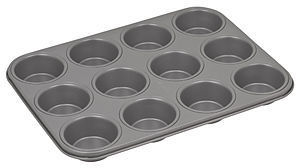 (Photo credit: Wikipedia)
(Photo credit: Wikipedia)March 22
My adopted daughter was born drug positive for cocaine, with prenatal exposure to an assortment of drugs and alcohol. She’s been in my care since she was three days old. I watched this innocent, tortured child suffer through five months of withdrawal, helplessly unable to comfort her. To carry her from her crib to her changing table caused her great pain, simply because I was touching her. My daughter was born an addict, no different than the junkie entering rehab.
Her eating delays became quite apparent at 9 months, as she would punch you if you approached her with a spoon. Attempt, after attempt, her defensive reaction heightened and was delivered with swiftness. We went for an evaluation with the Speech Department/Rehab at the Children’s hospital, a floor of the hospital that recognized us with familiarity already. She went stiff and rigid in the high chair when the therapist put a bib on her, and it went very sour, very quickly. She refused to even look at a high chair from that point on. I attempted to feed her picnic style during those months -sitting on a blanket on the floor. To this day, she calls it her picnic blanket. The therapist still claims that my daughter is the most defensive child to ever come through the therapy group at our Children’s hospital. Ever.
Now two and a half years old, we have made unimaginable strides in trust and bonding. My darling little cuddle bug, she is. She takes supplemental formula, and eats around 300 calories from food choices on a good day. Recently, we learned that she has food intolerances to dairy, soy, and corn – all of which were in her infant and toddler formula. What if her eating phobia and defensiveness stems from her first feeding experiences? The formula made her tummy feel bad, yet we kept giving that to her as the only option for food. I had no way of knowing, as her discomfort was easily disguised by symptoms of withdrawal, and I accepted our therapists’ diagnosis of Sensory Processing Disorder when she was four months old, long before I even considered that it was possible that she could be reacting to what she was eating.
She will eat fries and hashbrowns in any shape or form, so that is what I typically offer as her safe food. She will eat breaded chicken strips with her fingers. Recently, she asked me to cut her chicken strip into “pieces”, and, for the first time in her life, ate the pieces with a fork. I broke down in joyful tears because she doesn’t have to inspect it with her hands first. She just trusts that the chicken strips I give her are safe to eat.
We regularly have a cereal slurping session during the evenings, too, where she will now completely participate with either dry cereal or a little bit of milk added. She eats roasted sunflower seeds, raisins, crackers, dried fruit, chips. Her only wet foods are yogurt (and only out of it’s original container), applesauce (and only out of a pouch), and frozen banana or mango puree. She will touch a soon to be accepted food and feed it to me for months before she is ready to try it herself. Lately, she’s been feeding me raw apples, pears, bacon, and frozen peas. I bread carrots and asparagus and add it to our hashbrowns and chicken strips (I make them all by hand) and she is at least touching them. I’m just started reading “Love Me Feed Me” and the no pressure approach. I can’t wait to start fine-tuning what we have already been doing!”
April 8
Buffet style working, working, working! We are in the beginning stages of this approach, but it is truly a happy dinner table! My daughter is handling foods by placing them on everyone’s plates and tonight, she put EVERYTHING up to her mouth. OMG!!!! Both my daughter and son nearly fight to set the table and sit and wait until I get everything in front of them. Not so great at clearing the table, though – LOL! I’m heading to the glassware place next week to pick out some perfect serving bowls and spoons for our new dinner parties – can’t wait!
Tonight, my daughter set the table and carried the bowl of sliced watermelon to the center. I was getting something out of the oven, and I look over and she was going to town licking it, sucking on it, she had a full plate of it! She didn’t eat any, but now she knows about watermelon!
April 15
We had spaghetti, breaded chicken, green beans, grated cheese, marinara sauce – all in serving bowls. Prior to the buffet style, if I would have sat down in front of her with a plate of spaghetti noodles, she would have fussed and became defensive – and certainly would never have touched them. Tonight, she served herself, placing each item on her plate. She ate half of a chicken strip. I purposely pushed one strip into her sauce pile when she wasn’t looking. (We do food chaining, too.) Sure enough, she noticed. But she still ate around the sauce!!!! That is new!
Then, she peeled her green beans apart to find the seeds, and started placing them in their own pile. She is really close to eating a bean seed! And for the spaghetti noodles? They got fondled as well, and for quite some time! She fed them to me, mostly, but that is how most of her accepted foods have made it to her mouth. She LOVES to set the table, and carry items to the center. We have been in feeding therapy for 1.5 years with a speech therapist, as she began with swallowing issues, we think. We have only been to doing this buffet model for 2 weeks (or less) and it has certainly changed the playing field at our house…literally!
I am currently shopping for serving bowls that can be more…..creative. I found a beautiful cabbage leaf bowl that we will call our “vegetable” bowl. I have a watermelon serving bowl, as well. I am also searching for a lazy susan to accommodate all this. My older child is a “picky” eater, and I’ve seen great strides in his level of willingness and tolerance of the foods he would have normally passed on.
May 3
Since we have begun the buffet style dinners combined with the Division of Responsibility, coming to the table to eat is highly anticipated. What I did before this is make a plate for everyone from the stove, then sit the plates at our chairs, and call everyone to the table. My picky was getting pickier, and my selective was getting OUT OF THERE! Now, as the food cools, the kids nearly fight with each other over who is going to set the table and carry the serving dishes!
Mr. Picky is doing much better, as he gets to choose what corner his food comes out of the serving dish. He eats, then wants to leave the table. I ask him to wait at the table with no obligation to eat, just keep us company, and he ends up eating more! Little Miss Selective takes lots of time with her examinations and takes occasional bites of the safes in the process.
When everyone is finished, my husband and son will start clearing the plates. I sit around with slow-poke. Then I will excuse myself, and one by one, start removing serving dishes. Before I do, I ask, “do you want one last scoop?” and secretly do cheers as she accepts more food. But this is also delivering the message that dinner time is ending, and it is time to move forward with our evening. Once, she even hopped out of her chair and came into the kitchen to me and said, “More!”.
My point of this story is that creating structure gives clear expectations of what comes next. My kids also know that closer to bedtime, we meet in the kitchen to look for a snack. Sometimes, they want to carry pretzels to the TV room. Sometimes, we decide we are going to make “nice cream” (frozen bananas made into soft serve texture), and they love to help with that. Sometimes, everyone slurps cereal at the table. My son has begun to ask me if there are leftovers of what we had for dinner! And he is eating very well at dinner! He used to refuse anything that was reheated.
I can’t believe that just a month ago, our table was an unhappy place for everyone, if they even came to the table. My son would want to leave after two minutes. My daughter didn’t want to be there at all. My husband would want it all to be over and I used to be furious with everyone, and end up sitting alone. A month later, I feel like I’m dreaming.
May 4
I attended the Mother/Daughter Tea and they served unfrosted muffins. “Not very fancy”, I thought, thinking “they could have done a little better here.” Anyhow, they started serving us and they put a muffin in front of my daughter. I giggled when they put another flavor down in front of me and thought, “Oh, good, I’ll get to try both”. She’s never, EVER, eaten a muffin.
Before the prayer, the teacher explained that she had a wonderful surprise for one of the moms, and it would just “be understood.” Prayer was over, and it was time for treats. My daughter peeled back the paper, and DEVOURED her muffin! All eyes were watching my reaction. They taught my daughter to eat cakes! They had been working with this since her first sign of interest. They had been learning and paying close attention to all I’ve been saying about our methods, our progress, our failures. I sat and cried at a tea party, touched by the generosity and feeling so amazingly grateful.
After I excused myself and bawled with pride and joy (while seated on a very low potty), my daughter’s pre-school teachers explained that it took a lot of tweaks and trials to come up with the presentation for her. The learned that no frosting was key, and no colors from fruit specks. One of the caregivers actually baked every week since November to work on this. My daughter’s food intake is up to 500 calories a day, and now with muffins on her list of accepted food, probably more!
How, just how, can I ever, ever, ever pay this back?
Back is not a direction parents of selective eating kids ever want to go. We tend to pay this sort of charity forward, because that’s where generous gifts of kindness truly flourish.
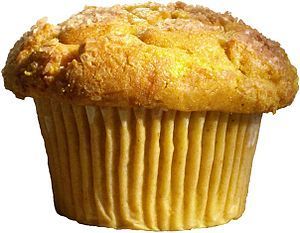 (Photo credit: Wikipedia)
(Photo credit: Wikipedia)THIS is the power of no-pressure feeding. Getting tough on your picky eater is only a recipe for problems, the very same problems that removing pressure from the table solves. Whether you are struggling with a picky eater, a selective eater, or you have a child that eats everything in sight, ask yourself this: Do you accept advice from a celebrity who admits he struggles at mealtimes with his own family, or do you trust the advice of a mom who serves trust, joy and hope with every meal?
The “experts” would be wise to offer less advice to parents, and spend a lot more time listening to them.
May 1, 2013
When a challenging, “She won’t like it” dish is for dinner (plus Thai Basil Noodle Salad recipe)
So the other night as I was menu planning, I was leafing through my 3-ring binder and came across a recipe I made last when I was pregnant! M has never had this meal (though she promised me she has had it before). It’s a Thai beef and basil salad, and I just didn’t think she’d like it. I have a fairly adventurous eater who happens to heartily enjoy the 10-12 dishes (and others) I make on a regularish rotation. I realized to my chagrin, that I don’t often make things I “know” she doesn’t like, like grilled cheese for example, which I had made when she was visiting the grandparents. Hadn’t made that for about 3 years. It’s been a while since having something totally new as the main entree.
So, I decided to walk my talk, and cook the foods I want to eat and want her to learn to enjoy. I made the salad (enjoy hot or cold) but I also made a cucumber salad she likes, and served a dessert that was filling and that she likes. (Whole foods single cup custard, cream, berries and cake that we split, and added cut up strawberries and banana.)
Thai Basil Noodle Salad
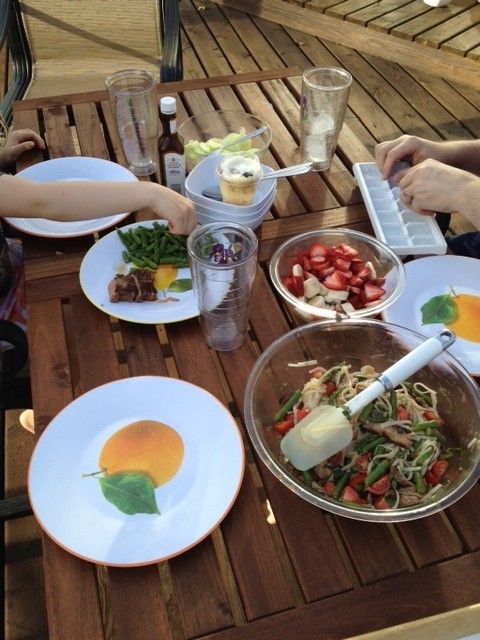
Prep time
15 mins
Cook time
15 mins
Total time
30 mins
Delicious, mild salad great hot or cold.
Author: Katja Rowell, MD
Cuisine: Thai (adapted from Cooking Light recipe)
Serves: 4-6
Ingredients
3 Tbspns fresh lime juice
¼-1/2 teaspoon Thai Red Curry paste
1 Tbspn fish sauce
1 Tbspn sugar
1 bunch asparagus (tough parts cut or broken off bottom, cut into 1 inch pieces)
¼ cup chopped fresh basil
¾ lb flank steak
8 oz rice noodles (More or less depending on size of family. This serves 4 with generous portions. Make more sauce if making more noodles. The original recipe called for 4 ounces, but I wanted more noodle to goodies ratio.)
1 cup halved cherry tomatoes
Instructions
Put large pot of water to boil with a pinch of salt. Heat medium skillet over medium-high heat with 2 Tbspns olive oil. Mix the sauce ingredients, lime juice, sugar, fish sauce, curry paste in medium sized bowl. (If you are new to cooking, do this in stages and assemble, if you are a seasoned cook, you can assemble and cook at the same time.)
Sear the flank steak, cook 4-6 minutes per side depending on thickness and desired doneness. Sprinkle with salt. Slice thinly across the grain.
Add the cut asparagus to the boiling water, cook about 4-6 minutes, until desired doneness. Remove the asparagus with a slotted spoon or sieve * keep the water boiling for noodles. Toss asparagus in the pan that the steak was seared in to get some of the flavor of the steak and oil.
Cook noodles in the boiling asparagus water, once asparagus removed. Drain noodles when done (use any rice or other noodle, cook based on directions on box).
Put noodles in large bowl, toss with ½ of sauce mixture. Add steak, asparagus, cherry tomatoes and basil to the medium bowl with the remaining sauce mixture, toss to coat, then add all ingredients to large bowl. Add basil and toss, or serve steak mixture on top of the noodles.
WordPress Recipe Plugin by EasyRecipe
3.2.1230
I figured she’d get enough to eat, but I totally empathize with that worry that your child won’t eat and will be hungry, and the lime and curry paste was a flavor she wasn’t really used to. I had too much steak and asparagus, so I left a piece of steak out, plain and sliced on a plate, as well as a small pile of asparagus (which I just ate as left-overs with pita bread and hummus. YUMMY!)
So, the table looked like above. The mixed salad, as well as a plate in the center of the table with plain steak, some A-1 sauce, plain asparagus, cucumber salad and dessert that we assembled at the table. I told her a little about the salad for context, “It’s not too spicy, there is steak and asparagus, and I last ate it when you were in my tummy! It tastes a little like our turkey curry.” She tried the salad (no suggesting or praise from mom or dad), said she liked it, but didn’t ask for seconds, and ate a very small portion for her (maybe 1/3 cup). NOTE, I did not announce that I put out the extra choices for her, “In case she didn’t like the new dish,” I just laid the table with all of it out there. I think it would have been fine, had I not had extra, to let her just get by with dessert and cucumber salad. She enjoyed the cucumber salad, and the fruit. To my surprise, she ate a lot of sliced banana, which is a fruit she has been refusing for awhile (bananas, like eggs and tuna are foods she eats for months on end, then rejects for months on end. All without drama mind you, just says, “no thank you” and moves on.)
tips:
1) Cut foods differently. This morning again she asked for banana “circles” and ate a whole banana, when she hadn’t touched them for months. In the past I’ve written about how this happened with carrots as well when she was about 4. Sticks? No way! Carrot coins? Yes please!
2) Serve familiar and safe foods with any new foods so your child can enjoy something. Avoid pressure or suggesting or praising for trying new foods
3) Cook foods you want to eat. So many clients share how grateful they feel when they can cook their favorites, and not just the child’s favorites again. Foodies, rejoice!
Have your kids surprised you by liking something you never thought they would? I remember M devouring pickled onions as a toddler!
April 23, 2013
latest Huffington Post blog on “expert advice”
You Can’t Always Count on Your Experts…
Those of you who know my blog may recognize some of these. Also, check out my series, “Stupid Things Experts Say.”
http://thefeedingdoctor.com/just-dont-bring-it-into-the-house-stupid-things-experts-say-5/
http://thefeedingdoctor.com/stupid-things-experts-say-about-food-and-weight-part-1/
Feel free to share, like and comment. Time to have more of a national discussion on feeding, and you can help!
We are sharing our best and worst feeding advice stories on FB. Join in!
organic but eating Fritos vs. spoiled snacks: my verdict? “should” ruins eating…
 My husband recently sent me a link to this Podcast, with “Judge” John Hodgman and guest Alton Brown, who help a couple decide who is right or wrong around eating decaying food and more. It’s worth a listen, and if you don’t want any “spoliers” (haha) stop reading, listen to the podcast and come back. Who is “right?” Never so simple around something as fundamental to life and self as food.
My husband recently sent me a link to this Podcast, with “Judge” John Hodgman and guest Alton Brown, who help a couple decide who is right or wrong around eating decaying food and more. It’s worth a listen, and if you don’t want any “spoliers” (haha) stop reading, listen to the podcast and come back. Who is “right?” Never so simple around something as fundamental to life and self as food.
Summary:
Husband: Eats spoiled food, rotten food, from the trash if he has to, fallen fruit on ground with dog poop. He also doesn’t order at restaurants and waits to finish what others are eating.
Wife: Buys lots of organic produce, and hates that her husband eats spoiled food. She even puts soap on food so he won’t eat it.
Simple, right? What husband is doing is gross and he must stop! The podcast is full of interesting tidbits about decay, avocados, and food safety, but what it came down to for me was this: Both of these folks let “shoulds” rule and ruin their relationship with food, and I’m sympathetic to both parties.
More:
Husband: says he hates food waste, (I would have liked them to probe a little more into his past, as I suspect food insecurity or poverty may have played more of a role), but it seems like an extension of his general desire to not waste anything, and maybe a little passive aggression thrown in. He thinks he “should” eat any food rather than let it go to waste.
Wife: Thinks she “should” eat healthier and so buys lot of organic produce that rots, since she’d really rather eat—and does eat—Fritos. To be clear, I have nothing against Fritos or organic food, but the point is she buys the organic, thinking it’s the right thing to do, but she doesn’t really seem to want to eat it, and doesn’t much of the time.
(Here is an older post about “should” and eating.) I too have had the virtuous food purchase (shocker, it was kale) rot in my fridge. I also grew up with a father who ate foods well past their prime, “It wants eating” he would say, gazing at the moldy cheese, and I would answer, “No, it wants throwing away.” (My father grew up in post-war rationing in Britain, where every crumb counted.)
Turns out my dad was right, as was the husband, at least with cheese and yogurt, and most things in the fridge in terms of safety, and if everyone consumed the way these two men did, our environment would be a lot better off, but I digress.
The verdict basically was for the wife to stop buying stuff she doesn’t eat, and for the husband to stop eating mangoes that have fallen on the poopy ground, and a few other things not in the fridge.
Seemed like a fun podcast to share and think a little more about how shoulds can spoil eating.
What are your shoulds? Do they help you feel good about food, eating and your body? Does it “work?”
April 18, 2013
portion minimums or maximums undermine healthy feeding
 I was giving a workshop on starting solids recently when two moms asked a similar question. “The doctor said my son has to drink X ounces of milk a day, and it’s so hard. If he hasn’t finished his pre-measured sippy cups, I end up chasing him around for an hour before bed time trying to get him to drink it.” A recent house-call revealed a similar scenario where minimum amount recommendations invited pressure into feeding. The parents were told by the pediatrician that the child had to eat X Tablespoons or fortified cereal every day, and Mom shared that she was anxious about getting it in, which led her to push her daughter with her early eating and battles and tears at the table. (Note, the baby was enjoying both breast-milk and formula, with the formula containing enough iron for minimums.) Another mother, on leaving the hospital with her newborn was told to feed a minimum number of ounces of breast milk a day, “Do whatever you have to to get food into that baby!” All of these absolute amounts encourage parents to freak out when the child eats less or more than recommended— inviting doubt and hyper-vigilance into the feeding relationship. (If you have a spreadsheet accounting for every ounce, it will be more likely to make you crazy than help you feed well.)
I was giving a workshop on starting solids recently when two moms asked a similar question. “The doctor said my son has to drink X ounces of milk a day, and it’s so hard. If he hasn’t finished his pre-measured sippy cups, I end up chasing him around for an hour before bed time trying to get him to drink it.” A recent house-call revealed a similar scenario where minimum amount recommendations invited pressure into feeding. The parents were told by the pediatrician that the child had to eat X Tablespoons or fortified cereal every day, and Mom shared that she was anxious about getting it in, which led her to push her daughter with her early eating and battles and tears at the table. (Note, the baby was enjoying both breast-milk and formula, with the formula containing enough iron for minimums.) Another mother, on leaving the hospital with her newborn was told to feed a minimum number of ounces of breast milk a day, “Do whatever you have to to get food into that baby!” All of these absolute amounts encourage parents to freak out when the child eats less or more than recommended— inviting doubt and hyper-vigilance into the feeding relationship. (If you have a spreadsheet accounting for every ounce, it will be more likely to make you crazy than help you feed well.)
Quantity absolutes are harmful to tuned-in feeding.
If you’re told your infant HAS to eat X amount of rice cereal a day, or MUST drink Y ounces of milk every day, or ingest X Tablespoons of vegetables, and you’re anxious and fighting to get to that mark, it’s not helping. (Same is true if your child wants to eat more and you are strictly limited to a maximum amount, as several of my clients have been directed to do, which led to increased anxiety and frantic eating over the months…) I know when my daughter was little there were meals where she ate many multiples of the “recommended” amount of banana for example. I remember getting anxious when she’d eat 1 1/2 bananas, when she was “supposed” to eat 1/4! Luckily I had learned enough to recognize my anxiety and skip the portion section, but it was still hard to reassure myself that she could be trusted. Similarly, parents of children with small appetites who may do fine on 2-3 bites of banana panic because their children aren’t eating that quarter banana!!
Recommended ranges are far more helpful. Some days it might be less, some days more, some days none at all. Larger babies, smaller babies, babies with different appetites will eat and enjoy more or less, with a large range from one day or week to the next. Follow your child’s lead, not a portion chart, or a feeding app that tells you to get two more bites in, or a rainbow chart that admonishes you if you missed orange and yellow for the day, in spite of a lovely intake of red, orange and green.
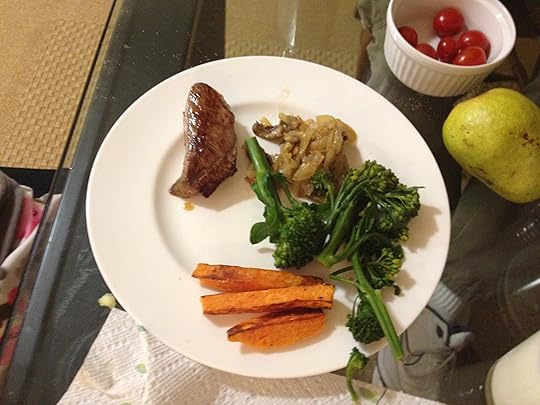 What? No purple or yellow!!??
What? No purple or yellow!!??
This is a plate a child served herself, no pressure, portions, or goading.
A child who is small and healthy may drink and need less milk than a child who is large and healthy. A child with a large appetite (who may be small) will eat or drink more than a child with a small appetite. (A child with lactose intolerance may not feel good when she drinks more than a cup or so of milk, or any at all.) It’s silly to make a blanket statement, or give exact calorie counts (link is worth the read…) or portions of fat by the 1/4 teaspoon—as if the child was a chemistry experiment where we could control every factor. But doctors and dietitians make these recommendations to my clients all the time. Absolutes lead to pressure around eating to get to that golden number, which leads to resistance and weight dysregulation.
If you find yourself working hard to “get” food in, or limit intake, step back, learn more, ask yourself if it’s working and how it feels. You shouldn’t have to work so hard.
As one mom shared in my book:
“One day my toddler ate apples for breakfast, sour cream and chives for lunch, brown rice with tamari for snack, and roasted chicken for dinner. It was wild. But after three years of this, I know I can relax because she knows what she needs. Her preschool teacher tells me she is the best example of mindful eating she has ever seen. Take that, USDA food pyramid or plate or whatever you are these days!” — Hillary, mother of a two-and-a-half-year-old
What do you think? What helps you trust your child’s intake, what has undermined it? Join the discussion on Facebook!
April 15, 2013
Asparagus sauce
sweet n tangy asparagus dressing
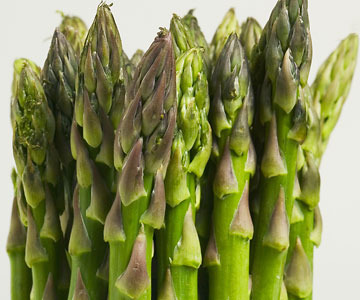
Prep time
5 mins
Total time
5 mins
Sweet and tangy sauce perfect for asparagus dipping!
Author: Katja Rowell, MD
Cuisine: ’70′s chic
Serves: 4
Ingredients
2 Tbspn miracle whip
2 tspn white vinegar
1-2 tspn ketchup
1 Tbspn evaporated milk
Instructions
mix, taste, play with ratios and enjoy!
WordPress Recipe Plugin by EasyRecipe
3.2.1230
It’s that time of year again! As the Germans call it, Spargelzeit! (I’ve never seen a culture so obsessed with asparagus…) The prices are coming down and the quality is going up. M helped me pick out a bunch of green and white so we could compare. Look for ones with dense, crisp tops. If the tops are slimy or pushed together they are not fresh. I love the thick, fresh spring ones!
We will enjoy them this evening with burgers. Tonight I will boil them (my parents used to have a special asparagus steamer) and then we will eat them with our fingers, dragging them in this sauce that I have always called, “Pink Sauce.”
M can make this from scratch now. It’s an easy sauce, and kids can start picking up on different flavors— if it needs more or less vinegar etc.
(Oh, and tomorrow we’ll eat the leftovers cold with just a little EVOO and white balsamic.)
Win my ebook, rename the “Pink Sauce” contest!
“Pink sauce?”

Prep time
5 mins
Total time
5 mins
Sweet and tangy sauce perfect for asparagus dipping!
Author: Katja Rowell, MD
Cuisine: ’70′s chic
Serves: 4
Ingredients
2 Tbspn miracle whip
2 tspn white vinegar
1-2 tspn ketchup
1 Tbspn evaporated milk
Instructions
mix, taste, play with ratios and enjoy!
WordPress Recipe Plugin by EasyRecipe
3.2.1230
It’s that time of year again! As the Germans call it, Spargelzeit! (I’ve never seen a culture so obsessed with asparagus…) The prices are coming down and the quality is going up. M helped me pick out a bunch of green and white so we could compare. Look for ones with dense, crisp tops. If the tops are slimy or pushed together they are not fresh. I love the thick, fresh spring ones!
We will enjoy them this evening with burgers. Tonight I will boil them (my parents used to have a special asparagus steamer) and then we will eat them with our fingers, dragging them in this sauce that I have always called, “Pink Sauce.” I have shared the recipe in a post before, and folks have told me the name is not very appetizing. So, I’m going to have a contest for the best new name for this old sauce, born I believe, in our asparagus-green 70′s kitchen.
What do you say? It really is yummy if you’re brave enough to try it! M can make this from scratch now. It’s an easy sauce, and kids can start picking up on different flavors— if it needs more or less vinegar etc.
We will vote on the winners on facebook, and the winner gets a free Kindle edition of Love Me, Feed Me.
(Oh, and tomorrow we’ll eat the leftovers cold with just a little EVOO and white balsamic.)
April 9, 2013
irresponsible conclusions on prompting kids to try new foods
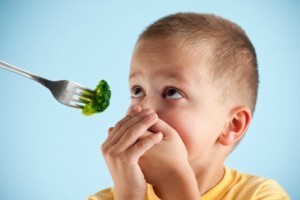
Some thoughts on the study, “Predicting Successful Introduction of Novel Fruit to Preschool Children.” From the Journal of the Academy of Dietetics and Nutrition. (links at bottom)
First and foremost, most of what busy clinicians (or parents, or “science reporters”) will read is the abstract or just the conclusion or press release, which is why I find this so troublesome. Whenever you see “evidence based,” know how problematic that can be, when the study has major limitations.
Conclusions:
“Prompting a child to eat and using rewards or bargains during a positive mealtime interaction can help to overcome barriers to novel fruit consumption. Early introduction of solids is also associated with greater willingness to consume a novel fruit.”
So, if all you read is the conclusion, you might think, “Hey, it is evidence based to instruct parents to bribe kids, reward them, and prompt them; maybe by putting food on their plate, or holding it out to them.” And parents may think, “If one prompt is good, several must be better!”
I think this is an irresponsibly worded conclusion given how weak the study is in terms of generalizability, and real-world applications. Here are my concerns with the study:
Study participants were self-selecting volunteers. (Parents willing to take part in studies are likely different from other parents, perhaps having children of a more easy-going temperament who might be willing to sit around for hours in a lab, or parents who have enough time, transport, and support, who are interested in child development etc.) The study did acknowledge that the parents were mostly well-educated, white and of high socioeconomic status
Only 25 children.
Served one meal in a laboratory setting. (Are the parents trying harder, being less or more forceful if they know exactly what behavior was being tested? Are older children trying to “be good” for the study?) The meal also had two sweet options and a bag of “crisps”, so the child may have been distracted, or full with the menu offered. (There are many variables you see.)
Parents were told they were being studied for ways to get kids to try new foods, that researchers were “interested in the types of strategies parents used to encourage children to try new foods.” How might these instructions have changed behavior?
Age range is 2-4 years, that is developmentally quite a large span.
Verbal and physical “prompts” in the conclusion? Seems so vague. Putting the food on the plate, or putting it in the child’s eye sight was considered a physical prompt. How far might parents take this?
They lump non-pressuring tactics like teaching: “There’s a stone inside” (fresh date), or frame of reference, “Well, it’s like a big grape, isn’t it?”
…with verbal prompts like, “Come and eat your date.” That’s a big difference, don’t you think?
1/3 of the children tried and enjoyed the fruit, probably about the number who would have anyway, without any prompting. (See below.)
In general, what is so often lacking in studies and nutrition education is the issue of the feeding relationship, the parent observing and responding to the cues from the child. If a child resists, becomes upset, or is not open to verbal or physical prompts, then it doesn’t help. It is far too easy for this to turn into pressure. Making these sweeping statements based on one meal in a laboratory setting with 25 kids is irresponsible.
Do the parent and child arrive at the lab with no history? What is the child’s temperament? Do they battle over foods already? There are many known factors that influence the feeding relationship that were not included in the study. Is the child one of the 1/3 of all children described as “picky,” who may have already been under great pressure and resisted over time? Are the children who enjoy the fruit part of the 1/3 (roughly) who are temperamentally more adventurous and more inclined to enjoy the food anyway? (See below.)
I just think it’s premature and dangerous to recommend pressuring tactics to get kids to try novel foods, when there is evidence that pressure backfires. Teaching parents to offer, model, not pressure and be responsive to their child’s needs would go a long way.
Other quotes from the study seem to indicate far more confusion and unclear results than the conclusion implies:
“Swallowing and enjoying the novel fruit, and the frequency of taste exposures to the novel fruit during the meal were related to physical prompting and the use of rewards and bargaining. However, these practices were also associated with children’s refusal behaviors such as physical and verbal refusal.”
“Where parents used greater verbal pressure and physical prompting, children more frequently refused the novel fruit physically and verbally, while also swallowing and enjoying it more frequently if physically prompted.”
“Rewarding/bargaining was also associated with a higher frequency of refusal, but also acceptance behaviors.”
“It is not unlikely that children who show greater refusal elicit greater verbal pressure or greater prompting from their parents.”
BELOW
This weekend we had a friend of M’s (C) over for dinner. I made Annie’s yellow mac-n-cheese with peas mixed in (I asked C in advance if it was okay to mix them in or if I should cook them on the side. She shrugged and said, “It’s okay.”) There was a little left-over asparagus which I cut into chunks and dressed with EVOO and white balsamic, there was some raw cauliflower and a little Ranch, and our natural casing hotdogs… C said she had never tried raw cauliflower, or asparagus salad. I told her our only rule was she didn’t have to eat anything she didn’t want to, even if she put it on her plate. I described the sauce on the asparagus. She said, “I’ve never tried those,” and served herself two pieces of asparagus and a small piece of cauliflower. She went for more cauliflower, no more asparagus, and said mid-meal, “Hm, I like the peas in the mac-n-cheese, I’ll have to tell my dad.” (She also talked about how picky her little bother is, and how tired she is of eating mac-n-cheese all the time because it’s what he likes. Same family, different child and temperament and circumstances.)
What do you think of the conclusion, the study and the feeding relationship, and prompts?
This is from Ellyn Satter Institute website. There is a wealth of resources here worth checking out.
Go to the bottom of the feeding and eating articles and resources page under current and controversial to see the original PDF of this study, Satter’s and the author’s responses…
April 2, 2013
Chocolate milk helps kids shed the pounds!
 This study about beverages and BMI (Public Health Nutrition Journal) in a sampling of Mexican American children showed that the more flavored milk kids drank, the lower the BMI. (Soda was associated with an increased risk of “obesity,” interestingly, juice and other sugar-sweetened beverages showed no effect…)
This study about beverages and BMI (Public Health Nutrition Journal) in a sampling of Mexican American children showed that the more flavored milk kids drank, the lower the BMI. (Soda was associated with an increased risk of “obesity,” interestingly, juice and other sugar-sweetened beverages showed no effect…)
OK, I don’t really believe that chocolate milk makes kids thinner, or fatter. I believe there is a complex play of factors, from genetics to poverty, to timing of meals and eating…
I just wanted to take a cue from “science” reporting, where study findings are extrapolated, and correlated, and twisted and biased (I’m making that into a verb), to get the desired headline. You can bet if the study showed that chocolate milk was associated with higher BMI, the headlines would scream, “Chocolate milk to blame for childhood obesity epidemic.” Also, banning sugar-sweetened beverages currently is the go-to answer for combating childhood obesity, and we continue to push low-fat milk and fat-free dairy, in spite of mounting evidence that dairy fat is not to blame for increasing BMIs, and some studies suggest that low-fat dairy products are associated with higher BMIs…
Sigh. It’s so confusing and anxiety-provoking, as we ricochet between dietary “culprits”, from fat to sugar to refined flour… I continue to advocate for family meals, the Division of Responsibility, feeding in a tuned in and responsive manner that respects the child’s internal regulation skills, and serving a variety of balanced and tasty choices (including chocolate milk, sometimes juice, and sometimes, even soda).
What do you think?





